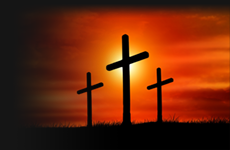Jesus' Crucifixion In Art
The symbol of Christ on the cross has infiltrated culture in innumerable ways, and depictions have become ubiquitous. There is no other subject matter that better reflects the historical progression of artistic expression. This is fitting, as there is no other event that has had comparable effect on all aspects of human history.

"The Crucifixion"
Artist: Paolo Uccello
1455
Painting
Constructed in a three-paneled triptych, in this painting, the artist includes many significant figures present at the Crucifixion as noted in the New Testament and of particular significance to the triptych's patron, Sister Felicity, a Bridgettine nun who lived at the convent, Santa Maria del Paradiso, close to Florence.
In the center panel, Christ is on the crucifix with the Virgin Mary standing to her son's right (our left). The work's current custodian, the Metropolitan Museum of Art, notes that the kneeling woman at the Virgin Mary's feet is likely Sister Felicity herself, for whom the work was made for her private devotional purposes. The woman in the white habit on the left panel is likely Saint Bridget of Sweden, the founder of the Bridgettine order of nuns and monks. Saint Bridget is also significant to the Crucifixion scene as she is known for having visions of Christ on the cross as a child (as well-as visions of the Nativity). The Nativity is in fact depicted in the right-hand panel in which the Virgin holds the infant Christ. The upper register of panels on both the right and left depict the Annunciation: the Angel Gabriel (on the left, winged, with red robes) tells the Virgin (seated in dark shroud on the right) that she would give birth to the Son of God. Depictions of the Virgin Mary and Christ featuring multiple times in a single work is not unusual in Early Renaissance artwork where asynchronous scenes were accepted practice.
This work is tempera on wood, gold ground. It is housed in the Metropolitan Museum of Art in NY City.

"Crucifixion Diptych"
Artist: Rogier van der Weyden
1460
Painting
This large, starkly dramatic work picks up many of the themes and approaches that Van der Weyden used throughout his career, giving equal weight to Christ's suffering and to the anguish of the witnesses to his death. The scene is set before a blank stone wall over which are draped two bright red cloths of honor, below a dark blue-black sky. In the left panel, a swooning Virgin Mary is supported by Saint John the Evangelist, both weeping and both dressed in unusually pale robes. In the right panel, Christ hangs heavily from the cross, the blood running down his forehead echoed by the tears of Mary and John. Despite the shallow space and limited setting, the skull and bone on the ground mark the site as Golgotha, or Calvary, where Christ was crucified, and where Adam, the first man, is said to have been buried, while the dark sky corresponds to the biblical description of the moment of Christ's death.
This oil on oak panels artwork is in The Philadelphia Museum of Art in Philadelphia, Pennsylvania.
- page 9 of 38 -
